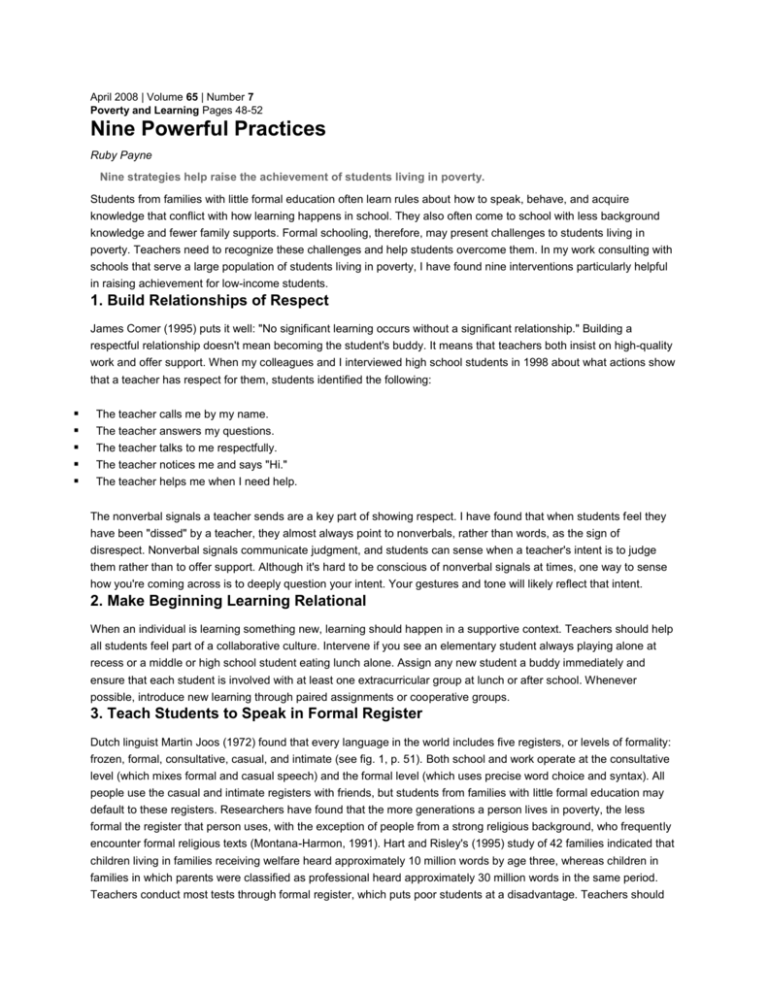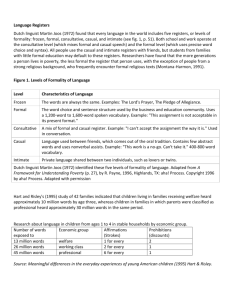9-Instructional
advertisement

April 2008 | Volume 65 | Number 7 Poverty and Learning Pages 48-52 Nine Powerful Practices Ruby Payne Nine strategies help raise the achievement of students living in poverty. Students from families with little formal education often learn rules about how to speak, behave, and acquire knowledge that conflict with how learning happens in school. They also often come to school with less background knowledge and fewer family supports. Formal schooling, therefore, may present challenges to students living in poverty. Teachers need to recognize these challenges and help students overcome them. In my work consulting with schools that serve a large population of students living in poverty, I have found nine interventions particularly helpful in raising achievement for low-income students. 1. Build Relationships of Respect James Comer (1995) puts it well: "No significant learning occurs without a significant relationship." Building a respectful relationship doesn't mean becoming the student's buddy. It means that teachers both insist on high-quality work and offer support. When my colleagues and I interviewed high school students in 1998 about what actions show that a teacher has respect for them, students identified the following: The teacher calls me by my name. The teacher answers my questions. The teacher talks to me respectfully. The teacher notices me and says "Hi." The teacher helps me when I need help. The nonverbal signals a teacher sends are a key part of showing respect. I have found that when students feel they have been "dissed" by a teacher, they almost always point to nonverbals, rather than words, as the sign of disrespect. Nonverbal signals communicate judgment, and students can sense when a teacher's intent is to judge them rather than to offer support. Although it's hard to be conscious of nonverbal signals at times, one way to sense how you're coming across is to deeply question your intent. Your gestures and tone will likely reflect that intent. 2. Make Beginning Learning Relational When an individual is learning something new, learning should happen in a supportive context. Teachers should help all students feel part of a collaborative culture. Intervene if you see an elementary student always playing alone at recess or a middle or high school student eating lunch alone. Assign any new student a buddy immediately and ensure that each student is involved with at least one extracurricular group at lunch or after school. Whenever possible, introduce new learning through paired assignments or cooperative groups. 3. Teach Students to Speak in Formal Register Dutch linguist Martin Joos (1972) found that every language in the world includes five registers, or levels of formality: frozen, formal, consultative, casual, and intimate (see fig. 1, p. 51). Both school and work operate at the consultative level (which mixes formal and casual speech) and the formal level (which uses precise word choice and syntax). All people use the casual and intimate registers with friends, but students from families with little formal education may default to these registers. Researchers have found that the more generations a person lives in poverty, the less formal the register that person uses, with the exception of people from a strong religious background, who frequently encounter formal religious texts (Montana-Harmon, 1991). Hart and Risley's (1995) study of 42 families indicated that children living in families receiving welfare heard approximately 10 million words by age three, whereas children in families in which parents were classified as professional heard approximately 30 million words in the same period. Teachers conduct most tests through formal register, which puts poor students at a disadvantage. Teachers should address this issue openly and help students learn to communicate through consultative and formal registers. Some students may object that formal register is "white talk"; we tell them it's "money talk." Figure 1. Levels of Formality of Language Level Characteristics of Language Frozen The words are always the same. Examples: The Lord's Prayer, The Pledge of Allegiance. Formal The word choice and sentence structure used by the business and education community. Uses a 1,200-word to 1,600-word spoken vocabulary. Example: "This assignment is not acceptable in its present format." Consultative A mix of formal and casual register. Example: "I can't accept the assignment the way it is." Casual Language used between friends, which comes out of the oral tradition. Contains few abstract words and uses nonverbal assists. Example: "This work is a no-go. Can't take it." Intimate Private language shared between two individuals, such as lovers or twins. Dutch linguist Martin Joos (1972) identified these five levels of formality of language. Adapted fromA Framework for Understanding Poverty (p. 27), by R. Payne, 1996, Highlands, TX: aha! Process. Copyright 1996 by aha! Process. Adapted with permission Have students practice translating phrases from casual into formal register. For example, a student I worked with was sent to the office because he had told his teacher that something "sucked." When I asked him to translate that phrase into formal register, he said, "There is no longer joy in this activity." Teachers should use consultative language (a mix of formal and casual) to build relationships and use formal register to teach content, providing additional explanation in consultative register. 4. Assess Each Student's Resources One way to define poverty and wealth is in terms of the degree to which we have access to the following eight resources. Financial: Money to purchase goods and services. Emotional: The ability to control emotional responses, particularly to negative situations, without engaging in selfdestructive behavior. This internal resource shows itself through stamina, perseverance, and good decision making. Mental: The mental abilities and acquired skills (such as reading, writing, and computing) needed for daily life. Spiritual: Some belief in a divine purpose and guidance. Knowledge of unspoken rules: Knowing the unspoken norms and habits of a group. Physical: Good physical health and mobility. Support systems: Friends, family, and resource people who are available in times of need. Relationships and role models: Frequent contact with adults who are appropriate role models, who nurture the child, and who do not engage in self-destructive behavior. School success, as it's currently defined, requires a huge amount of resources that schools don't necessarily provide. Teachers need to be aware that many students identified as "at risk" lack these outside resources. Interventions that require students to draw on resources they do not possess will not work. For example, many students in households characterized by generational poverty have a very limited support system. If such a student isn't completing homework, telling that student's parent, who is working two jobs, to make sure the student does his or her homework isn't going to be effective. But if the school provides a time and place before school, after school, or during lunch for the student to complete homework, that intervention will be more successful. 5. Teach the Hidden Rules of School People need to know different rules and behaviors to survive in different environments. The actions and attitudes that help a student learn and thrive in a low-income community often clash with those that help one get ahead in school. For example, when adult family members have little formal schooling, the student's environment may be unpredictable. Having reactive skills might be particularly important. These skills may be counterproductive in school, where a learner must plan ahead, rather than react, to succeed. If laughter is often used to lessen conflict in a student's community, that student may laugh when being disciplined. Such behavior is considered disrespectful in school and may anger teachers and administrators. Educators often tell students that the rules they come to school with aren't valuable anywhere. That isn't true, and students know it. For example, to survive in many high-poverty neighborhoods, young people have to be able to fight physically if challenged—or have someone fight for them. But if you fight in school, you're usually told to leave. The simple way to deal with this clash of norms is to teach students two sets of rules. I frequently say to students, You don't use the same set of rules in basketball that you use in football. It's the same with school and other parts of your life. The rules in school are different from the rules out of school. So let's make a list of the rules in school so we're sure we know them. 6. Monitor Progress and Plan Interventions One teacher alone cannot address all students' achievement issues. Monitoring and intervening with at-risk kids must be a schoolwide process. Take the following steps: Chart student performance and disaggregate this data by subgroups and individuals. Keeping in mind your district's learning standards, determine which content you need to spend the most time on. Bloom (1976) found that the amount of time devoted to a content area makes a substantial difference in how well students learn that content. Set up a collaborative process for teachers to discuss learning standards and make these determinations. Plan to use the instructional strategies that have the highest payoff for the amount of time needed to do the activity. For example, teaching students to develop questions has a much higher payoff for achievement than completing worksheets. Use rubrics and benchmark tests to identify how well students are mastering standards; discuss the results. Identify learning gaps and choose appropriate interventions. Interventions can include scheduling extra instruction time, providing a supportive relationship, and helping students use mental models. Schedule these activities on the school calendar regularly. 7. Translate the Concrete into the Abstract To succeed in school, students need to move easily from the concrete to the abstract. For example, a kindergarten teacher may hold up a real apple and tell students to find a drawing of an apple on a given page. Even though the two-dimensional apple on the page doesn't look like the real apple, students come to understand that the drawing represents the apple. In math, students need to understand that a numeral represents a specific number of items. Teachers can help students become comfortable with the abstract representations characteristic of school by giving them mental models—stories, analogies, or visual representations. Mental models enable the student to make a connection between something concrete he or she understands and a representational idea. For example, in math, one can physically form a square with the number of items represented by any square number. We can teach students this concept quickly by drawing a box with nine Xs in it. The student can visually see that 3 is the square root of 9, because no matter how the student looks at the model, there are 3 Xs on each side. Excellent teachers use mental models all the time, although they may not call them that. I have found that using mental models decreases the amount of time needed to teach and learn a concept. 8. Teach Students How to Ask Questions When you have asked a student what part of a lesson he or she didn't understand, have you heard the reply, "All of it"? This response may indicate that the student has trouble formulating a specific question. Questions are a principal tool to gain access to information, and knowing how to ask questions yields a huge payoff in achievement (Marzano, 2007). In their research on reading, Palincsar and Brown (1984) found that students who couldn't ask good questions had many academic struggles. To teach students how to ask questions, I assign pairs of students to read a text and compose multiple-choice questions about it. I give them sentence stems, such as "When ___________ happened, why did __________ do ___________?" Students develop questions using the stems, then come up with four answers to each question, only one of which they consider correct and one of which has to be funny. 9. Forge Relationships with Parents Many low-income parents are so overwhelmed with surviving daily life that they can't devote time to their children's schooling. Even when time is available, the parent may not know how to support the child's learning. It is essential to create a welcoming atmosphere at school for parents. Ask yourself these questions about the kind of experience parents have when they enter your building: How are parents usually greeted? With a smile, a command, a look, or the parent's name? What is the ratio of educators to parent in meetings? Six educators to one parent? Many parents experience such a situation as being "ganged up on." To avoid this perception, designate a person to greet the parent five minutes before the meeting starts and tell him or her who will be present and what is likely to happen. This is much better than having the parent walk into the room cold. When the meeting is over, have all the educators leave the room (and don't have another obvious consultation in the parking lot). The person who met the parent ahead of time should walk the parent out of the building, ask how he or she is feeling, and find out whether the parent has more questions. Is the language used in parent meetings understandable, or is it "educationese"? Are parents often asked to make interventions they do not have the resources to make? Do parents realize that people at the school care about their children? Parents want to know first whether the school cares about and respects their child. Communicate this message early in the conference. It also helps to say, "We know that you care about your child, or you wouldn't be here." I recommend doing home visits. Arrange to have a substitute for a particular day and send a letter home to a few parents saying that because teachers always ask parents to come to school, a pair of teachers would like to come by their house, say hello, and bring a gift. The gift should be something small, such as a magnet listing the school's name, phone number, and hours. If a parent wants to have an in-depth talk about the child, schedule a time that's good for both parties to talk further. Schools that have taken this approach, such as East Allen County Schools in Fort Wayne, Indiana, have strengthened the rapport between parents and teachers and lessened discipline referrals. The Gift of Education Educators can be a huge gift to students living in poverty. In many instances, education is the tool that gives a child life choices. A teacher or administrator who establishes mutual respect, cares enough to make sure a student knows how to survive school, and gives that student the necessary skills is providing a gift that will keep affecting lives from one generation to the next. Never has it been more important to give students living in poverty this gift. References Bloom, B. (1976). Human characteristics and school learning. New York: McGraw-Hill. Comer, J. (1995). Lecture given at Education Service Center, Region IV. Houston, TX. Hart, B., & Risley, T. R. (1995). Meaningful differences in the everyday experience of young American children. Baltimore: Paul H. Brookes. Joos, M. (1972). The styles of the five clocks. In R. D. Abrahams & R. C. Troike (Eds.), Language and cultural diversity in American education (pp. 145–149). Englewood Cliffs, NJ: Prentice-Hall. Marzano, R. J. (2007). The art and science of teaching: A comprehensive framework for effective instruction. Alexandria, VA: ASCD. Montana-Harmon, M. R. (1991). Discourse features of written Mexican Spanish: Current research in contrastive rhetoric and its implications. Hispania, 74(2), 417–425. Palincsar, A. S., & Brown, A. L. (1984). The reciprocal teaching of comprehension-fostering and comprehension-monitoring activities. Cognition and Instruction, 1(2), 117–175. Ruby Payne is President of aha! Process. Her most recent book is Under-resourced Learners: Eight Strategies to Boost Student Achievement (aha! Process, 2008); RubyPayne@msn.com.









